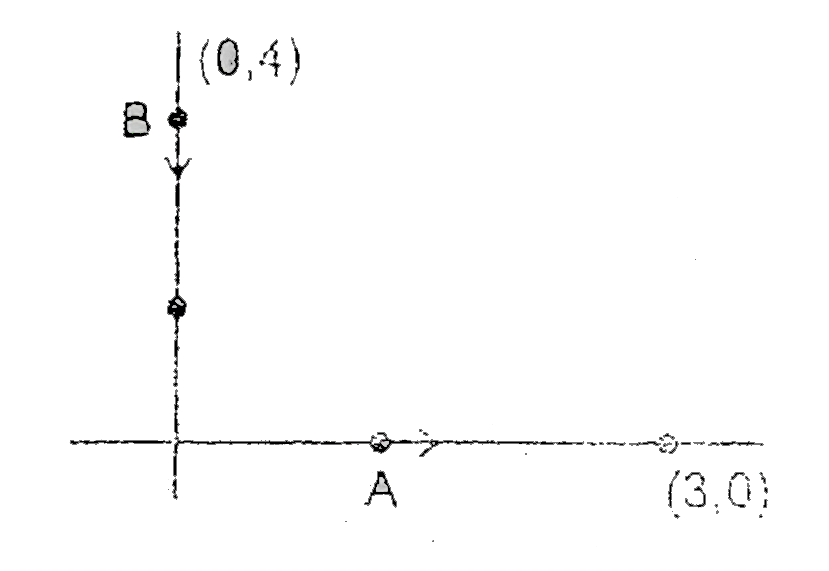Two particles A and B are performing SHM along x and y-axis respectively with equal amplitude and frequency of 2cm and 1Hz respectively. Equilibrium positions of the particles A and B are at the coordinates [3cm,0] and (0,4cm) respectively. At t=0,B is at its equilibrium position and moving towards the origin, while A is nearest to the origin and moving away from the origin-
Equation of motion of particle B can be written as-
The correct Answer is:10
At t=0 Particle 2 is at point V and mocing towards origin so displacement
Y=4−Asinωt
Y=4−2sinωt
and displacement of particle 1 is
X=3−Acosωt
X=3−2cosωt
So distance between them =√X2+Y2
s2=29−(16sinωt+12cosωt)=29−4(4sinωt+3cosωt)
⇒29−20(sinωt+37∘)
So s2max=49⇒smax=7cm=S1
s2min=9⇒smin=3cm=S2
∴S1+S2=10cm

Topper's Solved these Questions
- BOOK - RESONANCECHAPTER - SIMPLE HARMONIC MOTION EXERCISE - Exercise- 2, PART - III12videos
SIMPLE HARMONIC MOTION
- BOOK - RESONANCECHAPTER - SIMPLE HARMONIC MOTION EXERCISE - Exercise- 2, PART - IV8videos
SIMPLE HARMONIC MOTION
- BOOK - RESONANCECHAPTER - SIMPLE HARMONIC MOTION EXERCISE - Exercise- 2, PART - I26videos
SIMPLE HARMONIC MOTION
- BOOK - RESONANCECHAPTER - SEMICONDUCTORSEXERCISE - Exercise 388videos
SEMICONDUCTORS
- BOOK - RESONANCECHAPTER - TEST PAPERSEXERCISE - FST-330videos
TEST PAPERS
Similar Questions
Two particles A and B performing SHM along x and y−axis respectively with equal amplitude and frequency of 2cm and 1Hz respectively. Equilibrium positions of the particles A and B are at the co-ordinates (3,0) and (0,4) respectively. At t=0,B is at its equilibrium positions and moving towards the origin, while A is nearest to the origin and moving away from the origin. If the maximum and minimum distances between A and B is s1 and s2 then find s1+s2 (in cm).
View Solution(i) A particle of mass m executes SHM in xy- plane along a straight line AB. The points A (a, a) and B (- a, - a) are the two extreme positions of the particle. The particle takes time T to move from one extreme A to the other extreme B. Find the x component of the force acting on the particle as a function of time if at t = 0 the particle is at A. (ii) Two particle A and B are performing SHM along X-axis and Y-axis respectively with equal amplitude and frequency of 2 cm and 1 Hz respectively. Equilibrium positions for the particles A and B are at the coordinate (3, 0) and (0, 4) respectively. At t = 0, B is at its equilibrium position and moving toward the origin, while A is nearest to the origin. Find the maximum and minimum distances between A and B during their course of motion
View Solution
Knowledge Check
- Question 1 - Select One
Two particles A and B are performing SHM along x and y-axis respectively with equal amplitude and frequency of 2cm and 1Hz respectively. Equilibrium positions of the particles A and B are at the coordinates [3cm,0] and (0,4cm) respectively. At t=0,B is at its equilibrium position and moving towards the origin, while A is nearest to the origin and moving away from the origin-
Minimum and maximum distance between A and B during the motion is-A√5cm and √61cmB3cm and 7cmC1cm and 5cmD9cm and 16cm - Question 2 - Select One
Two particles A and B move along the straight lines x+2y+3=0 and 2x+y−3=0 respectively. Their positive vector, at the time of meeting will be
A3ˆi+3ˆjB3ˆi−3ˆjCˆi3−ˆj3DParticles never meet - Question 3 - Select One
A particle is performing SHM along x-axis with amplitude 6.0 cm and time period 12 s. What is the minimum time taken by the particle to move from x=+3cm to x=+6cm and back again?
A1 sB2 sC4 sD6 s
A particle is performing SHM along x−axis with amplitude 4.0cm and time period 1.2s . What is the minimum time is deci− second taken by the particle to move from x=+2cmto x=+4cm and back again.
View SolutionA particle moving with S.H.M. has velocitiesof 4cm/s and 3cm/s at distances of 3 cm and 4 cm respectively from the equilibrium position. Find
(a)The amplitude of the osciallation
(b) Time period
(c ) The velocity of the particle as is pases through the equilibrium position.View SolutionA particle vibrates in SHM along a straight line.Its greatest acceleration is 5π2cms−2 and when its distance from the equilibrium position is 4cm ,the velocity of the particle is 3πcms−1
View SolutionTwo particles A and B oscillates in SHM having same amplitude and frequencies fA and fB respectively. At t=0 the particle A is at positive extreme position while the particle B is at a distance half of the amplitude on the positive side of the mean position and is moving away from the mean position.
View SolutionA particle of mass 10 gm is describing S.H.M. along a straight line with period of 2 sec and amplitude of 10 cm . Its kinetic energy when it is at 5 cm from its equilibrium position is
View Solution
